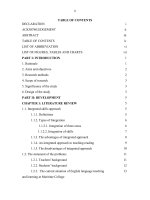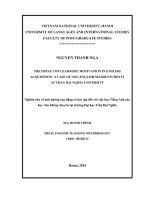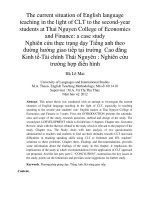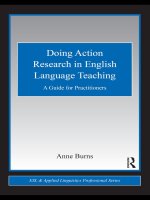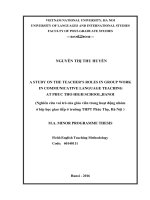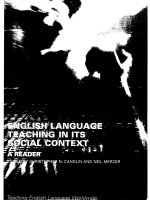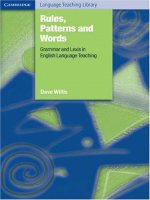7 colaborative writing in vietnamese secondary schools
Bạn đang xem bản rút gọn của tài liệu. Xem và tải ngay bản đầy đủ của tài liệu tại đây (185.14 KB, 7 trang )
7 Collaborative writing in Vietnamese secondary schools – an
innovative approach to teaching writing in a second language
Tran Thuy Duong, MA. Chu Van An National High School, Hanoi,
Vietnam.
Writing tends to be a neglected area in English language teaching at secondary schools in
Vietnam. Among the reasons behind this trend lies an assumption that a good piece of
writing is composed of grammatically correct sentences. Most hours of English instruction
in Vietnamese schools, therefore, put a great emphasis on teaching abstract rules and fixed
patterns. Such a structurally based approach to writing certainly plays a role in developing
students’ language knowledge. However, learning to write should go beyond the
boundaries of sentence structure to convey meanings and ideas, as it could be argued the
final aim of the majority of language programs is to develop learners’ communicative
competence, including the ability of effective self-expression.
With this view in mind, this workshop seeks to demonstrate a two-hour writing lesson as
part of the “Intensive Writing” course, a Course Design Project for ELT Professional
Practice at Warwick University where I completed an MA in ELT. The development of the
materials is based on Badger and White’s (2000) model of process genre approach to
teaching writing. Through emphasising various discourse structures of a written text and
the intended audience of the text, the lesson intends to get learners involved in different
stages of a writing process, from the generation of ideas and writing the first draft, to the
revising, editing of work and the publication of the essay.
The lesson is aimed at promoting students’ creativity, confidence and independence in
English learning through collaborative writing, real life tasks, consciousness raising
activities, peer-feedback activities and the use of portfolio as assessment for creative
learning.
The first distinctive feature of the lesson is it seeks to provide real life tasks relevant to
what students will do in the outside world. Writing essays for the school forum on a variety
of issues raised by teenagers will likely encourage students’ interests in learning and allow
students to draw on present realities and meet their distant future goals of effective
communication. This view is shared by Kaplan (2001), believing that writing is both a
communicative and internally motivated activity. Therefore, writing on a topic of their own
choice rather than teacher assigned tasks would stimulate learners’ motivation and increase
creativity.
Another distinction is a number of consciousness raising activities designed to involve
learners’ participation in pair work and group work to find out the rules for themselves.
These activities aim to encourage students to move steadily away from dependence on
teachers to becoming more confident and self-reliant. One example might be learners
noticing the text pattern or discourse features of an argumentative text through labelling
each paragraph of the sample text with its functions before reaching an explicit
understanding of the overall structure. Consciousness-raising activities can promote
learners’ retention because they have to learn through self-exploring, and as Schmidt
(1990:144, in O’Brien, 2004:10) argues, “those who notice most learn most, and it may be
that those who notice most pay attention most”.
Taking a perspective that writing is a communicative act, the emphasis of the lesson is to
draw students’ involvement in collaborative writing at different stages of the writing
process. Group discussion to brainstorm the topic would likely generate a variety of ideas
from which each individual could benefit and learn from their peer’s strengths. It also
builds up students’ sense of teamwork when each member makes the highest quality
contribution to the successful completion of the task. Drafting is accomplished individually
based on the group’s selection of content and logical sequence of arguments with the help
of the teacher as a facilitator or consultant. The revision stage includes whole-class
feedback given by teacher on common problems in the first draft, followed by students
giving comments on a peer’s first draft and the final revision. Peer-feedback activities
allow for peer writer-reader interaction and help students refine their drafts by diagnosing
their own mistakes with the help of a peer and a checklist on organisation, content and
language use prepared by teacher. Learning through self-exploration and negotiation of
meaning in the revision session will likely lead to students’ improvement in writing and
establish a sense of taking responsibility for their own learning.
A process-oriented approach to writing would require a new form of assessment that could
address different aspects of writing rather than the traditional holistic marking. Students’
works are assessed in terms of portfolios, including their first drafts, the final pieces of
written work and their reflections on the process of composing the final products. The final
products will be graded according to how much progress the students have made in going
from first ideas, to drafting, revising and editing. Portfolios will be marked on the basis of
students’ improvement in writing throughout the course. Portfolios can provide teachers a
wider view of students’ progress by “focusing on both the process and product of learning”
and can be seen as evidence of students’ self-development and enable students “to
demonstrate their potential for future development” (Paltridge, 2001:114).
Contrary to the widely held belief among students that writing is a lonely activity where the
writer works at his own pace in silence and suffers to convey the meaning with no one to
help out, this workshop has demonstrated that a supportive learning environment in the
classroom context with the help of peer and teacher as a facilitator could stimulate learners’
motivation and develop their confidence in writing. It has also been evidenced from the
lesson that writing whole pieces of communication for intended readers rather than simply
producing single correct sentences tends to encourage students’ creativity and interests in
second language writing.
Actual Session Breadown
I. Introduction 15 minutes
* Brief summary about the Intensive writing course designed for the English majors at Chu
Van An National High School (slide show, computer) : 8 minutes
Ladies and Gentlemen,
Welcome to the workshop on interactive writing. This is a demonstration lesson, which is
part of the intensive writing course designed for intermediate students aged between 16 and
18 at Chu Van An National High School in Hanoi, Vietnam. The course aims at developing
students’ ability to communicate effectively in real life situations.
The degree to which students have learnt from the lesson is assessed in terms of portfolio,
which is made up of students’ first draft, second draft and the final product.
The course is intended to be carried out for the period of 14-week term with one hour (60
minutes) of instruction a week.
The goal of the lesson is to
* Help students undergo different stages of the writing process:
• Sample text analysis
• generating ideas
• writing the first draft
• whole class feedback
• peer editing and feedback
* Raise students’ awareness of the audience
Students will be able to
• Participate in group work to brainstorm the main ideas of the issue discussed.
• Share and present the group’s ideas with other groups
• Write the first draft
• Give peer feedback
* Now I would like to introduce a short film of 12 D3 writing lessons : 4 minutes
- Generation of ideas
- Group presentation
- Group writing
*Introduction of D3 forum (log on to the webpage of D3) : 3 minutes
One distinctive feature of the course is the writing topics are chosen by the students, rather
than teacher-assigned tasks. In this way, students feel more motivated and interested, as
these are the issues raised by the members of 12D3 or other students within the school. All
essays written by students are posted to D3 forum – a webpage designed by 12D3.
Over the past two months students have discussed such topics as “How to be an attractive
girl”, “Your favourite book and author”, “Should secondary students go dating”
- Main page
- English Club
- Students’ discussion
- This week topic raised by Hong Nhung : Students tend to have preference
for extracurriculum activities rather than typical academic course.
II. Pre-writing activities 25 minutes
1. Sample text analysis : 8 minutes
Functions Sentence
Position taken (author’s view)
(1)
First argument
Evidence/examples to support the first argument
Second argument
Evidence/ examples to support the second argument
Third argument
Evidence/ examples to support
Evaluation and restatement of position taken
Q2. How can we predict the main content of paragraph 2,3,4? Did the author give any
signal in the opening paragraph? Underline these signals, if there are any.
T.
• Give a sample argumentative text for analysis (OHP)
• Provide consciousness-raising activities
Ss
• Label the paragraphs with their functions
• Underline topic sentences, the author’s statement of purpose, supporting evidence,
restatement of purpose in the conclusion
2. Brainstorming : 5 minutes
• Discuss the issue
• Generate main ideas and find supporting examples/evidence
• Make a list of vocabulary related to the topic
• Write down the main ideas discussed on the transparencies
3. Group presentation 12 minutes
• Ss. share the ideas with other groups, using OHP.
• Other groups listen and give additional information
III. While-writing activities 10 minutes
Ss. write the first draft in group
IV. Post-writing activities 15 minutes
1. Whole class feedback 10 minutes
• Ts. provides a student’s text taken from the previous topic (OHP)
• Ss., with the help of Ts., give feedback on content, organization, language use
Activity 1
Step 1 Read the first draft of your essay . Complete the following checklist about the
structure of an argumentative essay. ( in the of Yes or No)
Checklist 1: self-evaluation
Structure of an argumentative essay
Have you stated your opinion on the issue? Yes No
Have you provided one main argument in each paragraph? Yes No
Have you provided evidence or examples to support your
arguments?
Yes No
Have you restated your position in the conclusion? Yes No
Step 2 Exchange the first draft of your essay with your partner. Read the essay of
your partner carefully and complete the checklist
Activity 2
Step 1 Read your essay again and complete the following checklist about the content of
your essay. ( in the of Yes or No)
Checklist 2: self-evaluation
Content of the essay
Have the main arguments in your essay supported your position in
the opening paragraph?
Yes No
Have the examples or evidence provided relevant information to
support the argument in each paragraph?
Yes No
Are the examples provided relevant to the question you have
discussed?
Yes No
Step 2 Exchange the first draft of your essay with your partner. Read the essay of your
partner carefully and complete the checklist



